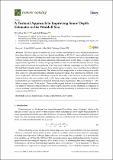| dc.contributor.author | Mei, M. Jeffrey | |
| dc.contributor.author | Maksym, Ted | |
| dc.date.accessioned | 2020-05-21T15:45:06Z | |
| dc.date.available | 2020-05-21T15:45:06Z | |
| dc.date.issued | 2020-05 | |
| dc.date.submitted | 2020-04 | |
| dc.identifier.issn | 2072-4292 | |
| dc.identifier.uri | https://hdl.handle.net/1721.1/125380 | |
| dc.description.abstract | The snow depth on Antarctic sea ice is critical to estimating the sea ice thickness distribution from laser altimetry data, such as from Operation IceBridge or ICESat-2. Snow redistributed by wind collects around areas of deformed ice and forms a wide variety of features on sea ice; the morphology of these features may provide some indication of the mean snow depth. Here, we apply a textural segmentation algorithm to classify and group similar textures to infer the distribution of snow using snow surface freeboard measurements from Operation IceBridge campaigns over the Weddell Sea. We find that texturally-similar regions have similar snow/ice ratios, even when they have different absolute snow depth measurements. This allows for the extrapolation of nadir-looking snow radar data using two-dimensional surface altimetry scans, providing a two-dimensional estimate of the snow depth with ∼22% error. We show that at the floe scale (∼180 m), snow depth can be directly estimated from the snow surface with ∼20% error using deep learning techniques, and that the learned filters are comparable to standard textural analysis techniques. This error drops to ∼14% when averaged over 1.5 km scales. These results suggest that surface morphological information can improve remotely-sensed estimates of snow depth, and hence sea ice thickness, as compared to current methods. Such methods may be useful for reducing uncertainty in Antarctic sea ice thickness estimates from ICESat-2. | en_US |
| dc.description.sponsorship | National Aeronautics and Space Administration (Grant NNX15AC69G) | en_US |
| dc.description.sponsorship | US National Science Foundation (Grant ANT-1341513) | en_US |
| dc.publisher | Multidisciplinary Digital Publishing Institute | en_US |
| dc.relation.isversionof | http://dx.doi.org/10.3390/rs12091494 | en_US |
| dc.rights | Creative Commons Attribution | en_US |
| dc.rights.uri | https://creativecommons.org/licenses/by/4.0/ | en_US |
| dc.source | Multidisciplinary Digital Publishing Institute | en_US |
| dc.title | A Textural Approach to Improving Snow Depth Estimates in the Weddell Sea | en_US |
| dc.type | Article | en_US |
| dc.identifier.citation | Mei, M. Jeffrey and Ted Maksym. "A Textural Approach to Improving Snow Depth Estimates in the Weddell Sea." Remote Sensing 12, 9 (May 2020): 1494 © 2020 The Author(s) | en_US |
| dc.contributor.department | Massachusetts Institute of Technology. Department of Mechanical Engineering | en_US |
| dc.relation.journal | Remote Sensing | en_US |
| dc.eprint.version | Final published version | en_US |
| dc.type.uri | http://purl.org/eprint/type/JournalArticle | en_US |
| eprint.status | http://purl.org/eprint/status/PeerReviewed | en_US |
| dc.date.updated | 2020-05-14T13:55:45Z | |
| dspace.date.submission | 2020-05-14T13:55:45Z | |
| mit.journal.volume | 12 | en_US |
| mit.journal.issue | 9 | en_US |
| mit.license | PUBLISHER_CC | |
| mit.metadata.status | Complete | |
